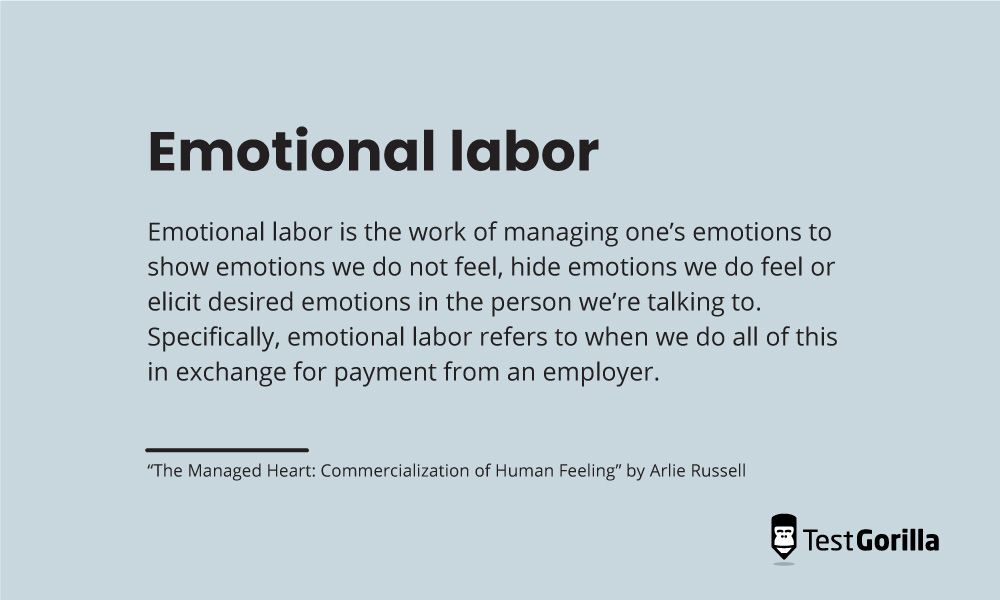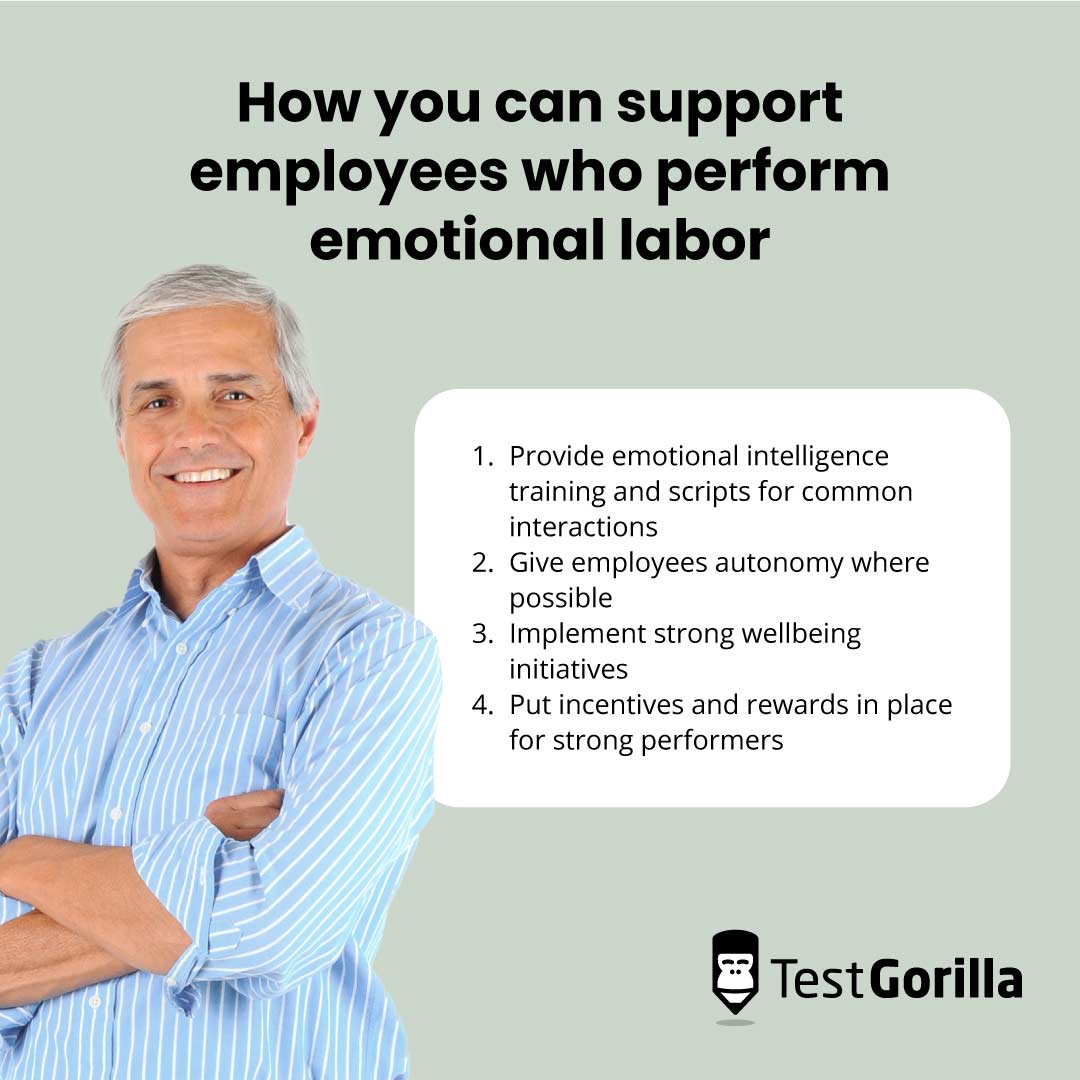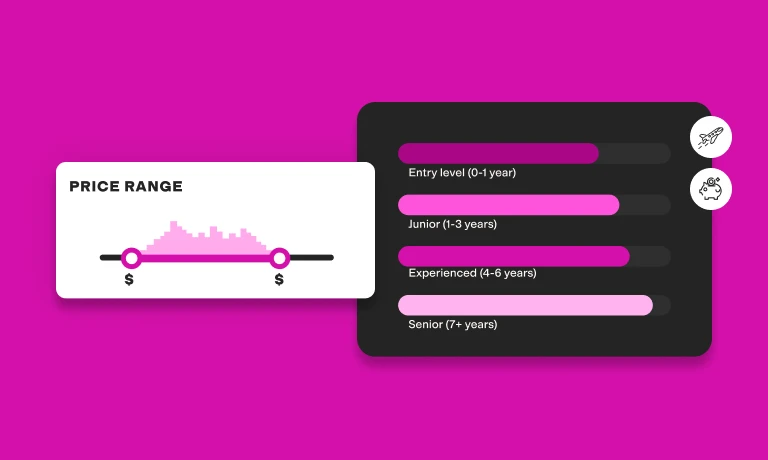How understanding emotional labor can help you hire and develop great employees
“Emotional labor” is a buzzword that’s been thrown around a lot in the past few years. It seems to mean everything and nothing.
Listening to your friend in another department express their anxiety about an upcoming deadline? Emotional labor. Deleting exclamation marks from your emails? Emotional labor.
Taking your dog for a walk? You guessed it – emotional labor.
The thing is, none of these things is actually emotional labor (especially that last one).
In this blog, we clear up what exactly emotional labor is and why it’s fundamental for HR leaders to understand it.
We also explain the effect of emotional labor on your workforce, how it relates to emotional intelligence in the workplace, and how you can use your newfound understanding to supercharge your hiring and development efforts.
Table of contents
- The mass misunderstanding of emotional labor
- What is emotional labor, really?
- The effects of emotional labor on your workforce
- How understanding emotional labor can improve your skills-based hiring strategy
- How you can support employees who perform emotional labor
- Use skills-based hiring to place emotionally intelligent candidates in roles that require emotional labor
- Sources
The mass misunderstanding of emotional labor
There has been a mass misunderstanding of the term “emotional labor.” To understand why, we have to go back to a 2017 Harper’s Bazaar article titled “Women Aren’t Nags – We’re Just Fed Up” by Gemma Hartley.
In the article, Hartley discussed emotional labor as the “thankless work” of taking care of a household: Organizing chores and anticipating the needs of a partner and children. In other words, the acts of daily care that typically fall on women.[1]
This meaning was taken up and popularized by multiple sources, even making its way into a “Stupid-Easy Guide to Emotional Labor” aimed at men, which gave emotional labor another name: “mandholding.”[2]
It soon expanded to include virtually any activity that required emotional regulation, from delegating chores to listening to a friend when they’re upset.
We can understand why this happened. After all, there are undeniable imbalances in which certain types of people are called upon the most to provide emotional and physical care, even though we might like to think there aren’t.
One study found that even though 94% of the people surveyed agreed that caring responsibilities should be shared equally, 52% of women who were joint carers said they did more than their fair share, while 30% of men admitted they did less.
However, this emotional work we do in our day-to-day lives is not quite the same thing as emotional labor. Let us explain…
What is emotional labor, really?
The term “emotional labor” originates from a 1983 book by Berkeley sociology professor Arlie Russell Hochschild, titled “The Managed Heart: Commercialization of Human Feeling.”
In “The Managed Heart,” Hochschild defines “emotional labor” as the work of managing one’s emotions to:
Show emotions we do not feel
Hide emotions we do feel
Elicit desired emotions in the person we’re talking to
Specifically, emotional labor refers to when we do all of this in exchange for payment from an employer.
Hochschild differentiated it deliberately from the “emotion work” we’ve discussed above – the process of managing our own emotions and the emotions of others in our personal lives.[3]
According to Hochschild, emotional labor requires two types of emotional acting. These are:
Surface acting
Deep acting
Surface acting is when workers mask their feelings by superficially projecting another emotion on top of them.
Deep acting, on the other hand, refers to when a worker aligns their real feelings with the desired ones for their role.
Hochschild based her theory on interviews and research conducted in the airline industry.
She talked to flight attendants, who frequently have to project calmness and a pleasant demeanor to allow customers to enjoy their flight (surface acting) and might think happy thoughts as a way to achieve this (deep acting).
You can see why walking the dog doesn’t fit now, right? Hochschild believes the uses of the term we described above are an overextension of the term, threatening to render it useless.[4]
Well, not on our watch.
Examples of emotional labor
To better understand how emotional labor works in practice, it’s useful to look at a few more examples.
Many so-called “low-skill” occupations require emotional labor, operating as they often do on the front lines of businesses by interacting with customers.
Customer service skills such as patience, communication, and empathy are used by professionals in many industries. For example:
Fast food chain managers, who might use surface acting when dealing with customer complaints
Psychotherapists, who remain calm and receptive even in the face of distressing information
Call center operators, who use cheery tones to give customers a positive experience when calling for help with a product or service
You can also find examples of emotional labor within recruitment. Human resources and hiring roles require emotional labor when dealing with candidates and employees. Creating a positive candidate experience while hiring requires emotional labor, such as:
Making candidates feel valued in written and phone communications
Putting candidates at ease during interviews
Ensuring unsuccessful applicants feel respected even when they are being rejected for the role
Similar emotional labor is required when working with existing employees.
Whether you’re mediating conflict between teammates or laying off employees with dignity and respect, mediating your own and others’ emotions is part of your job – and probably a pretty stressful one at times.
But what effect does emotional labor have on the workforce at large?
The best insights on HR and recruitment, delivered to your inbox.
Biweekly updates. No spam. Unsubscribe any time.
The effects of emotional labor on your workforce
Popular discourse around emotional labor mostly hinges on the idea that emotional labor is always draining and bad.
This is partly because the phrase emotional labor is most frequently evoked to describe the ways in which marginalized individuals are subject to imbalances in the workplace – for instance, from the social obligation to ignore microaggressions.
But this impression, although important to keep in mind, isn’t the full story.
Emotional labor can also be good for your employees and your business in certain situations.
A study published in 2023 found emotional labor can enhance workers’ job satisfaction and performance in some cases. In others, it caused burnout and poor job performance.
The key difference in outcome came down to employees’ use of surface acting (superficially presenting emotions different from our own) versus deep acting (changing the way we really feel).
Here’s how each type of acting can affect your employees.
Deep acting can have benefits for employees
By and large, deep acting has been found to be good for employees and businesses. A 2019 study found deep acting had a negative correlation with employee burnout.
Another study from 2015 found deep acting was positively correlated with job satisfaction, organizational commitment, job performance, and customer satisfaction.[5]
It makes sense to identify inwardly with your mission or truly empathize with a customer can give employees a sense of deeper purpose and value in their roles.
It was a different story, however, for surface acting – in other words, faking one’s emotions.
Surface acting can create detrimental effects
Surface acting has been found by numerous studies to have a detrimental effect on employee wellbeing, particularly when it comes to burnout and stress.
Although masking one’s emotions is necessary for many jobs, the disconnect between employees’ outward behavior and their authentic feelings has been linked to exhaustion and conflict.
One 2013 study conducted with a group of bus drivers found that daily surface acting increased emotional exhaustion, work-to-family conflict, and insomnia in drivers.[6]
A more recent 2019 study linked surface acting to heavy drinking for people working in roles with low self-control requirements or individuals who had fewer self-control traits.
Interestingly, the same study found certain factors modified these effects.
For instance, the negative effects of surface acting intensified when the employees had mainly service encounters, interacting somewhat impersonally with customers and the public.
They were buffered when they had service relationships with customers, including interacting with them as their patients, students, and clients.
Inequities exist in who takes on emotional labor
Although the emotional work we do outside of the workplace does not qualify as emotional labor, they are connected concepts. We see many of the same inequities emerge in emotional labor as we do in emotional work.
This is firstly visible in the fact women are far more likely to hold positions in which emotional labor is required. For instance, according to 2019 data, there are twice as many women as men working in customer service.
There are many potential explanations for this, one of them being that women are socialized to be better communicators from an early age.
Many studies have investigated the different ways boys and girls are taught to express their emotions, and research shows parents use more words that describe emotions when talking with daughters than sons.[7]
Women may therefore develop more complex emotional vocabulary than men, which helps them when identifying and managing their own and others’ emotions. This gives them more skills to succeed in jobs which require emotional labor.
However, it’s not simply the case that women succeed more often in being hired for these roles. Because these aptitudes develop very early, women may also be more likely to apply to some roles than others, which emerges in the gender application gaps we can observe across industries.
Employers can counteract these gender application gaps to some extent using skills-based hiring, but broader societal changes are needed in order to eliminate them completely.
Due to the limited research into how gender affects the rate of burnout among workers performing emotional labor, it’s difficult to know what effect these inequities have.
However, we might look at the gender gap in burnout rates more generally as some indication: Women workers burn out at a rate 32% higher than their male counterparts, perhaps partly due to this greater share of emotional labor.
How understanding emotional labor can improve your skills-based hiring strategy
With this understanding of how emotional labor affects your workforce, you can now look at mitigating these negative effects in your hiring and development initiatives.
Firstly, let’s look at hiring. Here’s how to apply your newfound understanding of emotional labor to your skills-based hiring initiatives.
1. Identify which roles most require emotional labor
The first step to applying your understanding of emotional labor to your hiring is, obviously, recognizing which roles require it. This is probably pretty clear to you already. If you’re a hiring manager then there’s yours, for a start, but perhaps you’ve also noticed it in others, such as your leaders’ roles.
Leaders have been asked to take on emotional labor more frequently in recent years. In fact, we frequently recommend that leaders engage emotionally with their employees in our blogs. We often say the best way to ingrain a cohesive company culture is for your leaders to act as role models.
For instance:
Being vulnerable and speaking up about mental health in company meetings
Being compassionate when dealing with failures and mistakes
Managing Zoom meetings to ensure that everyone is heard
With this understanding, you can add emotional intelligence to your hiring criteria for leaders, as well as demonstrating a deep alignment with your company values to prevent burnout.
You should also look out for other qualities that prevent burnout, such as self-compassion.
One study found when leaders outwardly engage in self-compassion, they help others with both their work tasks and their personal issues. Stakeholders consequently perceive them to be more competent.
The study found the effect was particularly strong for novice leaders lower down in the structure, so bear this in mind when hiring for managers who will be working closely with their direct reports.
2. Test candidates for emotional intelligence and culture add
It’s not difficult to see why emotional intelligence would come in handy for emotional labor roles. Understanding your own and others’ emotions is the first step to effectively managing them.
In fact, emotional intelligence was listed as one of the top 15 skills for 2025 by the World Economic Forum.
This is likely because artificial intelligence continues to be elusive when it comes to automating human interactions. AI might be getting better at dealing with emotions, but people still prefer humans to handle stressful queries.
Studies show that as the complexity of a customer service issue increases – for instance, with payment disputes – so too does customers’ desire for a face-to-face or phone interaction with a human agent.[8]
With this in mind, emotionally intelligent candidates are essential to growth even in an increasingly automated landscape, and the way to find them is through pre-employment testing.
Our top tip is to use a mixture of tests here. Don’t solely rely on personality tests.
Direct methods might include using a Leadership and People Management test to ask straightforward emotional intelligence questions. For example, asking how a candidate would deal with a dip in morale in their team.
Alongside these direct questions, you can use other tests to look at factors that indirectly inform emotional intelligence, like business ethics.
You should also use pre-interview assessments to ascertain which candidates have the culture add factor. In other words, rather than simply “fitting” your company culture, they align with its values while bringing a new perspective or way of working.
Hiring “culture add” candidates makes “deep acting” easier – and less of a burnout risk – because they already feel aligned with your company mission.
3. Use behavioral and situational judgment questions to assess emotional intelligence in interviews
Once you’ve shortlisted candidates based on the skills they demonstrated in their assessments, it’s time to evaluate them further in interviews.
The best way to do this is through a mix of behavioral and situational judgment questions that target emotional intelligence in the context of the role at hand. For instance, if you were hiring for a customer service role, you should include interview questions that focus particularly on communication and empathy.
For example:
Can you describe a situation in which you had to serve a difficult customer? Which approaches did you use to deal with the situation?
How would you handle a situation in which a client who hasn’t gotten the support or service they needed from several other businesses comes to you for a solution?
Have you ever had to de-escalate a situation involving a difficult client? Which techniques did you use?
These questions work best when used as part of a structured interview, which brings us to our last point.
4. Use structured interview techniques to compare candidates’ skills
Although the unstructured interview techniques favored by traditional hiring won’t stop you from noticing emotional intelligence in candidates, they do make it harder to compare candidates on qualities like these and slow down decision-making after an interview.
The key difference between unstructured and structured interviews is that in a structured interview candidates are asked:
The same questions
In the same order
Assessed using the same criteria, which are agreed on between stakeholders ahead of time
By asking all candidates the same set of questions, you can not only ensure that you don’t forget to assess any of them on emotional intelligence, but you can also directly compare their answers, perhaps even using numerical scoring.
Let’s say you asked them the second question above: “How would you handle a situation in which a client who hasn’t gotten the support or service they needed from several other businesses comes to you for a solution?”
Before the interview, you might agree on certain criteria with the team you’re hiring for. For instance, a good answer would prioritize emotionally intelligent responses like active listening and expressing empathy for how frustrating the situation must be.
You could assign a numerical grading system for answers based on how many of these key criteria they hit, and then you could compare candidates’ scores at the end.
How you can support employees who perform emotional labor
Hiring emotionally intelligent employees is only the first step. But as we’ve already seen, when left unsupported, even the best employees can be drained by emotional labor and burn out too quickly.
That’s why it’s especially important to prioritize employee wellbeing and development for emotional labor-intensive roles.
Here’s how to do it.
1. Provide emotional intelligence training and scripts for common interactions
We tend to think of empathy and communication as innate skills that can’t really be taught or improved, but that’s not true.
With the right upskilling initiatives, you can build your employees’ emotional skill sets, whether you’re adding to an already emotionally intelligent person’s repertoire or upskilling their team so they have more support.
You might do this through upskilling programs, such as:
Hosting workshops around communication and active listening
Providing conflict resolution training
Conducting bias awareness workshops that teach employees to introspect and practice empathy
The training itself is of benefit to your teams, of course, but equally important is creating an environment in which there is an ongoing, open conversation about emotions and emotional labor.
Indeed, it can have big benefits for your retention. Studies have shown when organizations handle emotional labor well and create a supportive environment, employees stay longer in their jobs.
2. Give employees autonomy where possible
Let’s face it. You can hire employees whose values align with yours and encourage teams to support them in their emotional labor, but there will still be many roles in which surface acting in impersonal interactions with the public is an inescapable part of the job.
These include customer-facing roles like call center operators who field calls from customers, but they might also include inside sales teams who face constant rejection from the potential clients they call.
Where possible, you should give your employees flexibility in how they handle their work because having autonomy over their work has been found to have a positive association with employee wellbeing.
Helping employees set boundaries at work can help them prioritize their mental health in moments when their frustration or exhaustion gets too much. You might do this by:
Setting guidelines around how often to take breaks and how long they can be
Employing flexible working hours
Allowing employees to take a certain number of short-notice vacation days when they feel overwhelmed
3. Implement strong wellbeing initiatives
Of course, the cornerstone of any strategy to reduce burnout and improve employee satisfaction is a strong wellbeing initiative, and there are many options to choose from when it comes to supporting people doing emotional labor.
One of the most impactful examples is to set up peer support systems for those in roles that require a lot of surface acting. In addition to giving workers autonomy, social support is one of the most effective resources you can give employees to reduce burnout.[9]
Social support is particularly effective when employees are free to share their feelings and empathetically respond to one another, and studies show it increases problem-solving ability, information sharing, and idea generation.
This is perhaps especially important in a remote workforce because failure to provide these connections to coworkers could isolate your employees and lead to working-from-home depression.
4. Put incentives and rewards in place for strong performers
Finally, it’s worth reminding yourself that emotional labor is just that – labor. Like any other work activity, it deserves to be incentivized and rewarded when expectations are exceeded.
Research suggests that far from cheapening the experience, financial rewards and incentives are fortifying to workers who perform emotional labor.
In fact, financial rewards in the services industry enhanced employee satisfaction, even from activities that involved surface acting, while job satisfaction from deep acting remained unaffected.[10]
The best way to reward and retain talent is to base your rewards schemes on things your employees want. Start by putting incentive-related questions in your engagement surveys, asking things like:
How satisfied are you with the current benefits?
How often do you take advantage of [benefit X]?
If you could add any reward to your compensation package, what would that be?
In your opinion, which are the least and most meaningful rewards we offer?
You can then use these to craft a rewards system or to inform how you use spot awards – small prizes, monetary or otherwise, that immediately recognize employee performance.
Evidently, when employees feel valued for their labor, whatever that labor may be, it helps reduce the strain of surface acting and promote a positive work experience.
Use skills-based hiring to place emotionally intelligent candidates in roles that require emotional labor
So, emotional labor doesn’t reach as far into our personal lives as we thought.
But it does permeate a lot of our working lives, and understanding how it works – which elements produce satisfaction and which provoke burnout – can help you make informed hires and craft effective wellbeing initiatives.
If you’re ready to think more deeply about how to support employees in your workplace, read our guide to being a trauma-informed workplace.
If you’re looking for a customer service professional whose surface acting skills are second to none, read our blog about customer service skills you should look for.
And to limit the burnout from deep acting for your next leader, hire using our Culture Add test.
Sources
Hartley, Gemma. (September 27, 2017). “Women Aren’t Nags—We’re Just Fed Up”. Harper’s Bazaar. Retrieved March 06, 2023. https://www.harpersbazaar.com/culture/features/a12063822/emotional-labor-gender-equality/
Moore, Tracy. (April 18, 2019). “The Stupid-Easy Guide to Emotional Labor”. MEL Magazine. Retrieved March 06, 2023. https://melmagazine.com/en-us/story/the-stupid-easy-guide-to-emotional-labor
Hochschild, Arlie Russell. (November 1979). “Emotion Work, Feeling Rules, and Social Structure”. American Journal of Sociology. Retrieved March 06, 2023. https://www.jstor.org/stable/2778583
Beck, Julie. (November 26, 2018). “The Concept Creep of ‘Emotional Labor”. The Atlantic. Retrieved March 06, 2023. https://www.theatlantic.com/family/archive/2018/11/arlie-hochschild-housework-isnt-emotional-labor/576637/
Humphrey, Ronald H; Ashforth, Blake E; Diefendorff, James M. (May 2015). “The bright side of emotional labor: The Bright Side of Emotional Labor”. Journal of Organizational Behavior. Retrieved March 06, 2023. https://www.researchgate.net/publication/277024957_The_bright_side_of_emotional_labor_The_Bright_Side_of_Emotional_Labor
Wagner, David T; Barnes, Christopher M; Scott, Brent A. (May 09, 2013). “Driving it Home: How Workplace Emotional Labor Harms Employee Home Life”. Personnel Psychology. Retrieved March 06, 2023. https://onlinelibrary.wiley.com/doi/10.1111/peps.12044
Chaplin, Tara M; Aldao, Amelia. (July 2013). “Gender Differences in Emotion Expression in Children: A Meta-Analytic Review”. Psychological bulletin. Retrieved March 06, 2023. https://www.ncbi.nlm.nih.gov/pmc/articles/PMC3597769/
Roesler, Peter. (December 18, 2017). “American Express Study Shows Rising Consumer Expectations for Good Customer Service”. Inc. Retrieved March 06, 2023. https://www.inc.com/peter-roesler/american-express-study-shows-rising-consumer-expectations-for-good-customer-service.html
Kim, Sunhee; Wang, Jaesun. (December 2018). “The Role of Job Demands – Resources (JDR) between Service Workers’ Emotional Labor and Burnout: New Directions for Labor Policy at Local Government”. International Journal of Environmental Research and Public Health. Retrieved March 06, 2023. https://www.ncbi.nlm.nih.gov/pmc/articles/PMC6313555/
Grandey, Alicia A; Chi, Nai-Wen; Diamond, Jennifer A. (April 11, 2013). “Show me The Money! Do Financial Rewards for Performance Enhance or Undermine The Satisfaction from Emotional Labor?”. Personnel Psychology. Retrieved March 06, 2023. https://onlinelibrary.wiley.com/doi/10.1111/peps.12037
You've scrolled this far
Why not try TestGorilla for free, and see what happens when you put skills first.























